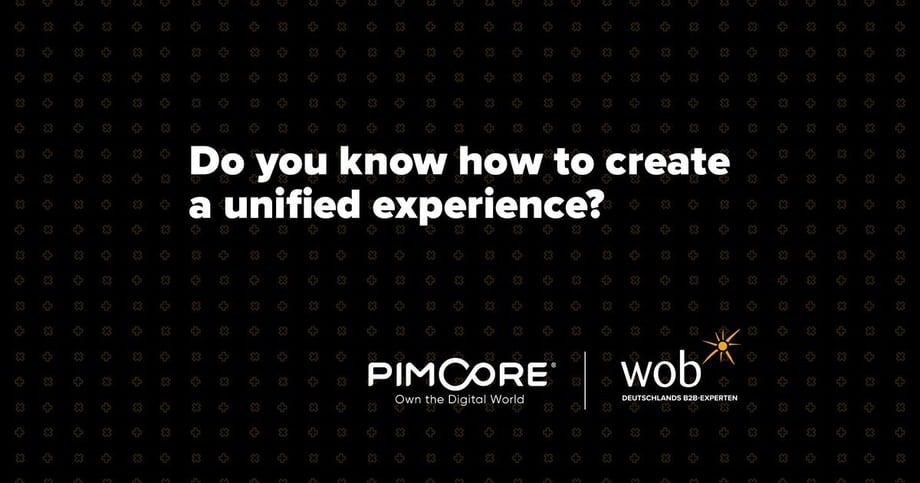
Unser Partner wob hat in den letzten Monaten in zahlreichen Beiträgen systemorientierte Perspektiven auf zeitgemäßes B2B-Marketing aufgezeigt. Nun möchten wir darauf eingehen, wie eine sogenannte Unified Platform Ihre verschiedenen Marketing-Technologien vereinen kann und Ihnen schon heute die Basis liefert, um die unbekannten geschäftlichen Herausforderungen von morgen zu meistern.
Schnelligkeit und Komplexität machen Insellösungen ineffizient
Haben Sie wegen der Pandemie auch schnell eine Plattform für virtuelle Veranstaltungen eingerichtet? Oder eine, die bessere Kampagnen und Lead-Generierung für Ihre Händler ermöglicht? Oder vielleicht eine zentrale Produktdatenbank, die die richtigen Inhalte auf Ihre Website oder in einen neuen Shop verteilt?
Dann wissen Sie bereits, dass Entschleunigung und Marketing nicht gut zusammenpassen - weder jetzt noch in Zukunft. Da viele der technischen Ansätze zur Bewältigung der unterschiedlichen B2B-Herausforderungen ähnliche Grundlagen haben, verlieren strategisch geführte Marketingabteilungen keine Zeit und arbeiten schon lange nicht mehr an Insellösungen. So gelten einheitliche Plattformen als das nächste große Ding im MarTech.
Flexibilität und Kompatibilität machen Unified Platforms so effizient
Eine Unified Platform bietet technische Infrastrukturen, die flexibel betrieben und kombiniert werden können. Diese technischen Infrastrukturen ermöglichen eine schnelle Integration wichtiger Funktionalitäten in eine neue Marketingplattform, so dass die Nutzer über mehrere Kanäle oder Touchpoints hinweg alles finden, was sie brauchen.
Allgemein sollten laut wob AG vor der Implementierung einer einheitlichen Plattform folgende Marketingfragen beantwortet werden:
- Wo werden die Produktdaten gespeichert und wie werden sie im Marketing verwendet?
- Wie werden Bilder, Videos und andere Inhalte für die verschiedenen Marketing-Ausgabekanäle (einschließlich des gedruckten Informationsblatts) verwaltet?
- Welche Website-Inhalte werden auch in anderen Zusammenhängen benötigt, zum Beispiel für Kampagnen?
- Wo werden die exklusivsten und immersivsten Angebote zusammengestellt und wie werden umfassende Nutzerprofile erstellt?
- Welche Nutzerdaten müssen vorhanden sein, um den Nutzern alles zu bieten, was sie brauchen, bis sie für einen Verkauf qualifiziert sind?
Von der einheitlichen Plattform zu einem einheitlichen Erlebnis
Allerdings profitieren nicht nur die IT- und Marketingabteilungen von den Vorteilen des Unified Platform-Ansatzes. Der Nutzer genießt dank einer Unified Platform ein sogenanntes Unified Experience, da er auf verschiedenen Kanälen oder Touchpoints die richtigen Informationen, angepasst an seine individuelle Situation, präsentiert bekommt - im richtigen Umfang, im richtigen Format und vor allem entsprechend seiner Interessen, Gewohnheiten und Vorlieben.
Unvorbereitet, aber bereit
Wenn Sie Ihren Zielgruppen auch in Zukunft ein inspirierendes Erlebnis über mehrere Marketingkanäle hinweg bieten wollen, ist eine robuste, einheitliche Plattform eine absolute Notwendigkeit. Schließlich weiß niemand, was in den kommenden Jahren von Marketingabteilungen erwartet wird und wie schnell bestehende Daten mit neuen Technologien verknüpft werden müssen. Um jedoch für alle Eventualitäten gerüstet zu sein, ist es sinnvoll, Antworten auf folgende Fragen zu finden:
- Kann hier ein Weg beschritten werden, der Flexibilität für die Zukunft bietet?
- Ist es möglich, an dieser Stelle eine ganzheitliche Aufstellung zu entwickeln, von der auch kommende Projekte profitieren können?
- Welche anderen Stakeholder könnten von einer robusten, einheitlichen Plattform profitieren und mit mir beim Aufbau dieses Systems zusammenarbeiten?
- Ist das gewählte System offen genug, um mit anderen Systemen zu interagieren?
- Und, was natürlich am wichtigsten ist: Stelle ich sicher, dass alle meine Zielgruppen über alle Touchpoints hinweg begeistert sind?
Ein kurzer Exkurs: "Headless" bedeutet nicht gedankenlos, wenn es um einheitliche Plattformen geht.
Die Unified Platform sorgt übrigens auch dafür, dass viele Inhalte und Daten anwendungsunabhängig verwaltet werden. Das bedeutet, dass sowohl Inhalte als auch Daten in Objekten des Systems gespeichert und nach Bedarf auf die verschiedenen Kanäle mit ihren jeweiligen Templates und Komponenten verteilt werden. Das System (Backend) ist sozusagen von der Ausgabe (Frontend) entkoppelt.
Dieser Headless-Ansatz erfreut sich seit geraumer Zeit zunehmender Beliebtheit, denn die zentrale Verwaltung von Inhalten (siehe PIM, CDP, MAM) spart den Redakteuren wertvolle Wartungszeit in mehreren Kanälen und die Nutzer können sich auf leistungsfähige Systeme und konsistente Informationen freuen. Mittlerweile bieten viele populäre Systeme Headless-Ansätze - darunter ehemals statische Tools wie eZ und Wordpress. Das Tool der Wahl der wob AG ist Pimcore, das seit jeher viele produktive Objektmerkmale teilt und daher als erstklassige Wahl für eine einheitliche Plattform angesehen werden kann.


